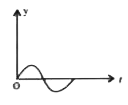Light passes successively through two polarimeters tubes each of length . The first tube contains dextro rotatory solution of concentration and specific rotation . The second tube contains laevo rotatory solution of concentration and specific rotation . The net rotation produced is Solution in Kannada
The correct Answer is:A
Observed rotation for the dextrorotatory solution, , where
specific rotation=0.01 rad
C=concentration=60
l=length of the polarimeter tube=0.29m.
rad.
Similarly, observed rotation for laevo rotatory solution,
Here, specific rotation=0.02 rad
C=30kg .
.
The rotations for dextrorotatory and laevo rotatory are in opposite directions. therefore, observed rotations for the two solutions are of opposite sign.
Net rotation
Topper's Solved these Questions
Similar Questions
A balloon starts rising from thee ground with an acceleration of 1.25m/s2. After 8 s, a stone is released from the balloon. The stone will (taking g=10ms−2)
02:30View SolutionThe displacement time graph of a particle executing SHM is as shown in the figure. The corresponding force-time graph of the particle is-
 02:42View Solution
02:42View SolutionLight passes successively through two polarimeters tubes each of length 0.29m . The first tube contains dextro rotatory solution of concentration 60kgm^-3 and specific rotation 0.01 rad m^2kg^-1 . The second tube contains laevo rotatory solution of concentration 30kg//m^3 and specific rotation 0.02 rad m^2kg^-1 . The net rotation produced is
02:10View SolutionSpecific rotation of sugar solution is 0.01SI units. 200kg−m−3 of impure sugar solution is taken in a polarimeter tube of length 0.25m and an optical rotation of 0.4 rad is observed. The percentage of purity of sugar in the sample is
04:59View SolutionA 300 mm long tube containing 60 cm3 of sugar solution produces an optical rotations of 10∘ when placed in a saccharimeter. If specific rotation of sugar is 60∘ calculate the quantity of sugar constained in te tube solution.
05:44View SolutionSpecific rotation of sugar solution is 0.5 deg m^(2)//kg . 200kgm^(-3) of impure sugar solution is taken in a sample polarimeter tube of length 20 cm and optical rotation is found to be 19^(@) . The percentage of purity of sugar is :
View SolutionA 200 mm long tube containing 48 cm3 of sugar solution produces an optical rotation of 11∘ when placed in a suucharimeter. If the specific rotation of sugar is 66∘ calculate the quantity of sugar contained in the solution of the tube.
View SolutionCalculate the amount of sugar dissolved in 10−3m3 of water so as to produce ratation of plane of polarisation of 12∘. Given the specific rotation of sugar solution is0.01radm−1kg−1m3 and length of polarimeter tube is 0.21m
02:50View SolutionA 22cm long tube containing 88cc of sugar produces an optical rotation of 9.9∘ when placed in a polarimeter. If the amount of sugar in the solution is 6g, calculation the specific rotation.
View SolutionA polarimeter tube of length 0.21m contains sugar solution of specific rotation 0.01 rad m^(-1)kg^(-1)m^(3) concentration. If the produced is 36^(@) , calculate the concentration of the solution. The solution is the tube is poured into a clean beaker and equal amount of water id added to it. The tube is then filled with the diluted solution. Calculate the angle of rotation produced.
02:51View SolutionLight passes successively through two polarimeter tubes each of length 0.29m. The first tube contains dextrorotatory solution of concentration 60 kg m−3 and specific rotation 0.01 rad m2kg−1. The second tube contains laevo-rotatory solution of concentration 30 kg m−3 and specific rotation 0.2 rad m2kg−1.The net rotation produced is :
03:40View SolutionThe specific rotation of liquid of length 1 dm , concentration 2.5kg/m3 is 40∘ . The angle of rotation is
02:44View SolutionThe light passes through two polarimeter tubes one after the other, each of which is 0.29m in length. 60kg in first tube m^(-3) Concentration and 0.01 radian mkg is the south perfection solution of specific rotation. 30kg / m concentration in the second tube and 0.02rad m^2 kg^(-1) Left rotator solution of specific rotation. The resulting rotation will occur
01:07View SolutionThe observed rotation of 2 gram of a compound in 10ml of solution in polarimeter tube of 25cm long is +24.6∘. The specific rotation of the compound (in degree) is
View SolutionIf the rotation is in clockwise direction, it is called dextro rotatory (d-) (or) (+) and in the anticlockwise, laevo rotatory (l-) (or ) (-)
02:45View SolutionThe observed angle of rotation of 2.0 gm sucrose containing 20 ml of aqueous solution in a polarimeter tube of 15 cm length is +15.3^(@) . What is the specific rotation of this solution of sucrose ?
04:23View Solution

